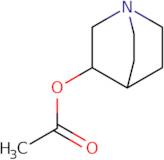Quinuclidin-3-yl acetate
CAS: 827-61-2
Ref. 3D-AAA82761
| 1g | Descontinuado | ||
| 5g | Descontinuado | ||
| 1mg | Descontinuado | ||
| 10mg | Descontinuado | ||
| 100mg | Descontinuado | ||
| 250mg | Descontinuado | ||
| 500mg | Descontinuado |
Informação sobre produto
- (3R)-3-(acetyloxy)-1-azoniabicyclo[2.2.2]octane
- (3S)-3-(acetyloxy)-1-azoniabicyclo[2.2.2]octane
- 1-Azabicyclo[2.2.2]Oct-3-Yl Acetate
- 1-Azabicyclo[2.2.2]octan-3-ol, 3-acetate
- 1-Azabicyclo[2.2.2]octan-3-ol, Acetate
- 1-Azabicyclo[2.2.2]octan-3-ol, acetate (ester)
- 1-Azabicyclo[2.2.2]octan-3-yl acetate
- 3-Acetoxyquinuclidine
- 3-Hydroxyquinuclidine acetate
- 3-Quinuclidinol, acetate
- Ver mais sinónimos
- 3-Quinuclidinol, acetate (ester)
- 3-Quinuclidinyl acetate
- Aceclidin
- NSC 657843
- dl-3-Quinuclidinol acetate
- Aceclidine
Quinuclidin-3-yl acetate (QCA) is a pharmacological agent that is used to prevent or treat urinary tract infections. It has been shown to inhibit the activity of acetylcholinesterase, an enzyme that breaks down the neurotransmitter acetylcholine, and reduce the levels of choline in the brain. QCA also binds to muscarinic receptors on cells in the eye, which may be responsible for its ability to reduce choroidal neovascularization and increase retinal blood flow. This drug is used as an antiseptic in surgical procedures and in contact lens solutions, where it prevents bacterial growth by inhibiting protein synthesis. QCA also inhibits sodium ion channels, which reduces pain perception and increases cell permeability.





